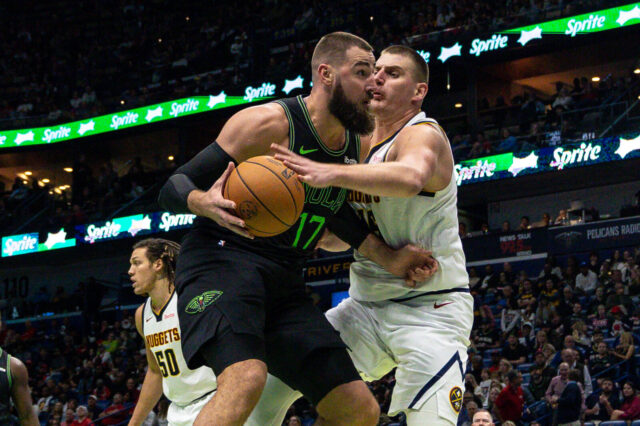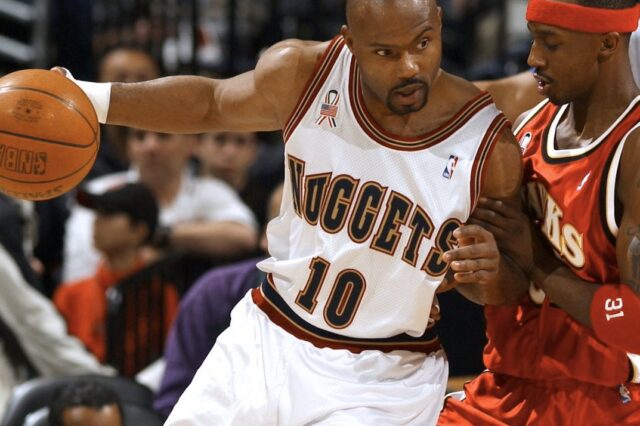1. The Denver Nuggets are top 10 in Offensive Rating, Defensive Rating, and Net Rating
Denver’s Offensive Rating of 111.1 points scored per 100 possessions (9th in the NBA) may not stand out by itself, but it should be celebrated when accounting for Defensive Rating as well. Nuggets shooters have struggled this year, and simply hitting their collective career averages from three-point range will elevate this ranking to elite levels.
What’s truly remarkable is the Defensive Rating of 101.8 points allowed per 100 possessions (3rd in the NBA) leading to the 3rd best Net Ratings in the league (+9.3). The Nuggets are a different style of ball club this year. While 101.8 is an ambiguous number across franchise history, Basketball Reference has a metric that ranks Denver’s Defensive Rating relative to the rest of the league at the time. Their -6.8 Relative Defensive Rating is the best in franchise history by a wide margin. For the first time in a long time, the Nuggets are excelling on the defensive end, and it has led to thrilling results.
2. The Nuggets have excelled in second and third quarters this season
Denver’s point differential by quarter lends to some interesting discussion on the Nuggets rotation, personnel, and mental make up.
- 1st quarter: -0.5 points per game (18th in NBA)
- 2nd quarter: +5.9 points per game (2nd)
- 3rd quarter: +2.6 points per game (6th)
- 4th quarter: +1.3 points per game (13th)
Some of these issues pertain to Denver’s inability to get off to fast starts due to a struggling starting lineup, but the bench has truly elevated Denver in the second quarter this season. The only times Denver didn’t tie or outscore their opponent in the second quarter were against the Los Angeles Lakers (a loss) and the Chicago Bulls (an overtime win/near loss).
3. Denver’s ON/OFF Net Rating Splits for every rotation player
Green = Good. Red = Bad.
This content is no longer available.
Will Barton was omitted due to a small sample size, but his numbers were green as well. Overall, this graph should excite Nuggets fans. It wasn’t nearly as green last season, and nitpicking a 9-1 record is truly diabolical.
But if there’s one concern, it’s Torrey Craig as the starting small forward. Opposing teams aren’t afraid of his spacing offensively, and his defensive traits, while impactful against certain players, aren’t always useful. Against the Boston Celtics, he started defending Kyrie Irving, and the Boston point guard made quick work of Denver’s defensive minded wing, assisting an easy bucket for Al Horford and canning a three-pointer on Boston’s first two possessions. Coach Michael Malone immediately removed him soon after missing an open three on the other end.
Monte Morris and Juancho Hernangomez are also watch points, given that Denver occasionally substitutes a starting guard over Morris at times in the second unit and that Juancho may become the starting small forward shortly. Despite those two factors, the Nuggets should be happy with where they are right now. Once a massive weak spot, the Nuggets are still performing at a relatively high level when they go to their bench.
4. The Nuggets average 99.56 possessions per game, 24th in the NBA
A natural byproduct of expending energy defensively, the Nuggets have slowed possessions down on defense and offense in comparison to the league around them. Last season, a 99.56 pace would have ranked 8th in the NBA. Denver doesn’t necessarily have to play slow in order to maintain solid defense, but there is the question of fatigue. How long can Nikola Jokic play great defense throughout the season while carrying Denver’s playmaking and occasional scoring load? If the Nuggets slow the game down, he could excel for longer periods of time in the game and across multiple games.
5. The Nuggets rank in the Top 10 in John Hollinger’s Four Factors on Defense
- Effective Field Goal Percentage allowed – 51.0% (10th in NBA)
- Turnover Rate generated – 13.7% (7th)
- Defensive Rebound Rate – 80.1% (5th)
- Free Throws to Field Goals Attempted ratio – 0.189 (9th)
Denver is the only team to rank in the top 10 in each of the above factors. I did a study on rebounding and its effect on winning games early last season, and the prognosis is that these four factors are massively important to team success. Denver’s success in each category demonstrates an intriguing versatility, which seems bizarre. The team is anchored by Nikola Jokic, who isn’t exactly fleet of foot. Despite that, his ability switching ball screens this year has allowed Denver to play more aggressively everywhere else. He will be beaten badly on occasion, but the math doesn’t lie. Overall, he has been awesome, with a massive assist to Paul Millsap, who’s playing like a Defensive Player of the Year candidate. More on that later.
6. Jamal Murray and Gary Harris have nearly identical stat lines by filling similar roles
This content is no longer available.
The similarities here are staggering. Last season provided some similarities, but now, the intriguing factor in Denver’s offense is their serving of similar roles. With the starters, Murray is usually the initiator at the top with Harris starting on the wing or in the corner, but with Nikola Jokic serving as the lead facilitator, Denver’s guards spend a lot of their time off ball as well.
This is emphasized by their bench roles as well. Generally, Monte Morris serves as the point guard while one of Murray or Harris serves as the shooting guard off ball. This allows each player to focus on scoring, and given their totals so far, they have been successful.
Once the three-point shooting climbs back to a respectable number, this duo will serve as one of the scariest guard combos in the NBA with Jokic finding them on the cut or spotting up along the perimeter.
7. Denver’s starting five is performing at a below average level
The quintet of Murray, Harris, Craig, Millsap, and Jokic has posted a -2.0 Net Rating in 120 minutes. That group has spent the sixth most time together as a unit, but only the Brooklyn Nets starting five has posted a worse Net Rating among units that have played more, and they feature Jared Dudley at power forward. Among all NBA starting fives, Denver ranks about 17th, slightly below average.
The team has been saved by their post starting five rotations, but as the ON/OFF Net Rating chart above suggests, the team has struggled to incorporate the lack of spacing and involvement from Torrey Craig. Shooting 15.8% from behind the three-point line and generated a 46.4% True Shooting mark, teams don’t have to respect Craig and can play 5-on-4 defensively.
Denver is reaching the tipping point of making a change, and Michael Malone said on Altitude Sports Radio yesterday that he would consider going with the best matchup at small forward. If he does make a change, expect Juancho to get the initial opportunity with an assist from small ball lineups featuring Morris and Malik Beasley.
8. The Nuggets are not capitalizing on open threes anymore
The NBA website classifies shots by closest defender into four categories: very tight, tight, open, and wide open. Open signifies four to six feet of space between shooter and defender, while wide open signifies six feet of space or more. On open three-pointers, the Nuggets are shooting just 32.3%, good for 19th in the NBA. On wide open three-pointers, the Nuggets are shooting a paltry 32.5%, 28th in the NBA ahead of only the Detroit Pistons and the Oklahoma City Thunder.
It’s important to note that the Nuggets, Pistons, and Thunder rank 26th, 29th, and 30th in overall three-point percentage respectively. Except, while the Pistons and Thunder struggle to space the floor with multiple wings and bigs that can’t shoot, the Nuggets guards are the biggest culprits. Murray averages 26.7% on open threes and 31.3% on wide open threes, while Harris averages 33.3% and 16.7% respectively. Murray struggled on open threes last season, but Harris shot 36.9%, and both were in the forties on wide open threes.
Once those two get out of their rut, the rest of the team will follow, but it’s a disturbing trend nonetheless. Murray scoring 48 points on Monday may turn things around for him. Harris hasn’t struggled this much as a shooter since his rookie year, so expect that to turn around as well.
9. Nikola Jokic is dependent on Paul Millsap defensively
Much has been made of Jokic’s improvement, and while he has deserved it, much of the credit goes to Paul Millsap. The power forward was signed in the 2017 offseason for this very purpose, and while it took longer than expected, his imprint on the team is taking hold.
With Millsap and Jokic on the floor, Denver’s Defensive Rating is a sterling 97.3.
With just Jokic on the floor, Denver’s Defensive Rating is a paltry 120.7.
It’s unfair to give Millsap all of the credit here. Jokic has spent less than 50 minutes without his running mate, and Millsap’s replacement defensively is usually Lyles and occasionally Juancho, so there’s definitely a downgrade in defensive talent and acumen. Despite that, it goes to show that Jokic’s defensive improvement only matters if there are smart defenders behind him to rotate and back him up.
10. The Nuggets still need a record of 41-31 to crack 50 wins on the season
It’s important to bask in the glory of the franchise’s hottest start in 40 years. The Nuggets knew they had to right the wrongs of last season by taking every game seriously, and so far, they’ve done that (at least enough to win).
But the NBA isn’t a sprint. It’s a marathon. Teams get hot at the right time or cold at the wrong time, and it could change the dynamic of their season. The Nuggets aren’t out of the woods yet by any stretch of the word, and a well placed three-game losing streak could impact Denver negatively in the months to come.
How Denver handles their initial success will show the true character and standing of the team going forward. So far, they have passed every test, but they aren’t even 15% of the way through the year. Will the team be as hot in January as they are now? In March? At season’s end?
Time will tell.


